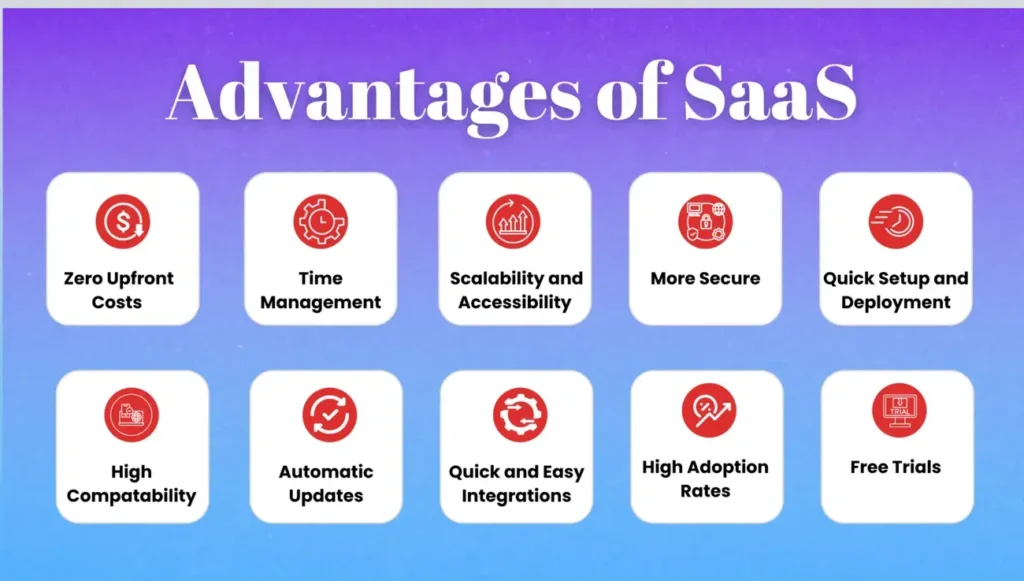
Have you ever wondered what benefits that Software as a Service (SaaS) provides to companies?
SaaS is the most commonly used option for businesses in the cloud industry. It is the most popular solution that is easily accessible, all you need is an internet connection and a browser.
Moreover, the previous ten years have seen explosive growth in the use of SaaS, primarily outside of the IT sector. Not just startups and small businesses, but even larger enterprises incorporate SaaS and break up their larger monolithic applications.
The market for software as a service (SaaS) grew from $31.4 billion in 2015 to an anticipated $1617.1 billion in 2022.

SaaS companies are becoming well-known in a variety of industries because they provide scalable, adaptable solutions that are affordable and simple to use, making them an ideal fit for businesses of all sizes. It is a hot-selling business model because it provides greater flexibility to the customer.
If you are in business and intend to take it to the next level, you will want to learn about its benefits. But before we delve into the SaaS advantages, let’s start with understanding what SaaS applications are.
What is Software as a Service (SaaS)?
Software as a Service is a form of cloud computing that delivers applications to the end-users. SaaS allows customers to access the service by connecting to the service provider’s network via the Internet.
SaaS is taking over the cloud computing market.
It is suitable for all kinds of businesses, making things easier and more efficient. Several financial service companies, technology companies, entertainment companies, and utilities have led the business world to adopt SaaS technology.
The main purpose of using the Saas is to:
- Improve scalability and accessibility while minimizing overhead and maintenance costs.
- Easily integrating with other platforms without expensive hardware and infrastructure.
- Removes the need for organizations to install and run applications on their computers.
Moreover, SaaS can be particularly beneficial for startups, small businesses, and larger companies with short-term or variable application needs. SaaS can enable companies of all sizes to deploy and scale applications as required quickly.
Why SaaS?
The main characteristics of SaaS are:
- Affordable software delivery method
- Accessible over the internet
- Hosted on a remote server
- Managed from a central location
Advantages of SaaS
Below are some benefits of software as a service that you need to know before moving to a SaaS platform.

1. Zero Upfront Costs
With SaaS, say goodbye to upfront costs.
One of the main software as a service advantages is cost-effectiveness. It eliminates the upfront costs the user has to pay for purchase and installation. The ongoing maintenance and upgrade costs are no longer a factor. To use SaaS software, you don’t need to purchase any additional software and hardware resources.
SaaS apps are easily downloadable and virtually maintenance-free from the user’s end. Therefore, it saves you from overspending on hardware resources.
For small businesses, SaaS benefits them by shedding the burden of costly hardware investments and complex deployment processes. It enables them to focus on growth and innovation.
2. Time Management
SaaS solutions help businesses in saving their time. The SaaS apps can be set up and deployed much faster compared to traditional on-premises software. Businesses don’t have to worry about hardware procurement, software installation, and configuration.
With SaaS, businesses don’t need to have an extensive in-house IT team to manage and maintain the software infrastructure. This frees up time for the business to focus on its core operations.
3. Scalability and Accessibility
Scalability is another one of the main benefits of software as a service. SaaS solutions can scale up or down easily to meet changing business needs, without the time and effort required for traditional on-premises scaling. It is an attractive option for businesses that want to keep costs under control while still benefiting from powerful software solutions.
Also, SaaS apps are accessible from anywhere with an internet connection, saving time by allowing employees to work remotely or on the go. It makes the situation a lot easier for home workers and people who work at multiple sites.
SaaS solutions help international companies with remote work. These cloud-based tools allow companies to hire qualified candidates from a wider geographic area, beyond just their local region.
Launch Your SaaS Product with NinjasCode
4. More Secure
SaaS is an excellent solution for any organization looking for a secure way to store sensitive data. SaaS solutions are more secure than on-premise applications. They are recognized for excellent security capabilities and won’t face any security or compliance problems.
SaaS is a desirable alternative for even the most security-conscious organizations because many businesses feel that their data is safer on the cloud than it is on their servers.
5. Quick Setup and Deployment
Implementing SaaS is faster than any other solution. SaaS applications are hosted and managed by the provider. Therefore, there’s no need for businesses to install any software or set up infrastructure on-premises. The application is accessible through a web browser or mobile app, making the initial setup very straightforward.
Since the SaaS application is already hosted and configured by the provider, businesses can start using the software immediately without any extensive deployment. This enables faster time-to-value compared to traditional on-premise software that requires lengthy installation and configuration.
6. High Compatability
Compatability is among the best advantages SaaS has. It increases the productivity of its users with all kinds of devices.
When you use the SaaS application, you don’t need to worry about the platform compatibility issues. The SaaS software is easily accessible through the web browser and the SaaS vendors ensure that all browsers support it. Also, if any components need to be downloaded, then it’s compatible with macOS, Windows, and Linux machines.
7. Automatic Updates
The utilization of SaaS applications never lets you go outdated. Users will not have to update the software manually because SaaS providers will do it automatically. Therefore, users will get a notification when anything is updated and changes in the software.
8. Quick and Easy Integrations
SaaS platforms typically provide robust API frameworks that allow businesses to integrate with various databases, applications, and third-party services. This enables businesses to create a connected ecosystem of tools that work together seamlessly, without the need for complex custom integrations.
The ease of integrating SaaS technology enables businesses to be more agile and responsive to changes in the market or their operational needs.
9. High Adoption Rates
It is one of the most popular benefits of software as a Service. SaaS applications are designed with user-friendliness in mind, with intuitive interfaces and streamlined workflows. This makes it easy for employees to quickly learn and start using the new software without hassle.
10. Free Trials
The SaaS providers offer free trials of the products. Therefore, businesses can take advantage of full trial versions to assess the solution’s viability before investing. They also determine how well the solution works with their organization’s programs before making any decision.
Challenges of SaaS
Which types of issues are associated with the SaaS?
While there are some benefits of software as a service, there are some challenges associated with it. It will be helpful to know before you decide to invest in such a solution.
Below are some challenges of SaaS.
Less Control Over the Software
With SaaS, the software is hosted and managed by the provider, which means businesses have less direct control over the application and its underlying infrastructure.
This can be a concern for organizations that have very specific or complex requirements that may not be easily accommodated by the SaaS providers.
Limited Range of Applications
While the SaaS market has expanded significantly, there may still be specialized or niche applications that are not available as SaaS offerings.
Businesses with unique or highly customized software needs may find the range of SaaS options limited compared to on-premises solutions.
Software Integration Issues
Integrating SaaS applications with a company’s existing on-premises software or other cloud-based tools can sometimes be challenging, especially if the APIs and integration capabilities are not well-developed.
This can create data silos and make it difficult to maintain a cohesive and connected technology ecosystem.
Examples of Software as a Service
As the market continues to expand, the adoption of SaaS solutions increases. By 2030, the global SaaS market is projected to reach over $900 billion, growing at a compound annual growth rate (CAGR) of 18.7%.
Here are some examples of software as a service that are widely used in the industry today.
CRM (Customer Relationship Management)
CRM is a well-known software for small businesses. This software helps businesses to keep track of all their activities. Also, it increases sales and marketing strategies. HubSpot is one of the leading and most popular SaaS solutions in this sector. It offers a CRM platform with all the tools and integrations you need for your business.
ERP (Enterprise Resource Planning)
ERP is a software that helps you manage numerous business processes such as accounting, risk management, procurement management, supply chain operations, and more.
Oracle is the most popular ERP that is used by several companies globally. It includes numerous solutions that help in many areas of business like finance, human resources, manufacturing, etc.
Project Management
Project management SaaS is designed to simplify project management and improve the collaboration between team members. It will help to organize your tasks better and boost productivity at the workplace. Jira. Trello, Asana, and Clickup are the most popular project management SaaS solutions.
Ecommerce
The ecommerce business is growing rapidly every year. New companies need to establish a strong online presence to gain simple access to a wider clientele. Businesses can instantly begin selling their goods and services due to SaaS solutions for retail and e-commerce.
This saves upfront costs for aspiring and established business owners developing a website, improving user experience, and creating user interfaces.
Shopify, BigCommerce, and Magento are the popular SaaS-based ecommerce platforms.
Conclusion
SaaS applications are best for small and medium-sized businesses to streamline their operations, grow their productivity, and improve collaboration. Now, you know the benefits of software as a service that will help you decide if you want to invest in such a cloud solution.
However, as some benefits vary from business to business, you will find many benefits of SaaS on your own as soon as you begin using such software. It’s likely that if you start using your SaaS software regularly, you won’t be able to stop.
Every kind of SaaS solution is designed with the specific purpose of giving your business the performance it requires and advancing your career objectives.
So, if you want to improve your business and overall work performance using a SaaS solution tailored to your unique business needs and objectives. You can schedule a meeting with us.
We are the best SaaS development service provider and help you in achieving your business objective with minimum investment.
So, get in touch with us and we make sure you benefit from all the advantages of SaaS so that you reach success within your niche.
FAQs
- What are the benefits of SaaS vs on-premise?
The main benefits of SaaS compared to on-premise software include:
- Lower upfront costs
- Easier and faster deployment
- Automatic updates
- Reduced IT management burden for the business
- Greater scalability and accessibility from any device
- How SaaS is different from traditional software?
The key differences between SaaS and traditional software are that SaaS is cloud-based and subscription-based, with the software and infrastructure managed by the provider. Whereas traditional software is installed locally and requires the business to manage the IT infrastructure and software updates.
- Why is SaaS better than PaaS?
SaaS is generally considered better than PaaS because it offers:
- Reduced complexity
- Faster time-to-value
- Greater scalability







